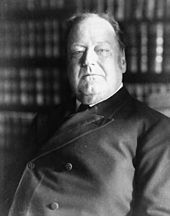| White Court | |
|---|---|
 | |
| December 18, 1910 – May 19, 1921 (10 years, 152 days) | |
| Seat | Old Senate Chamber Washington, D.C. |
| No. of positions | 9 |
| White Court decisions | |
 | |
The White Court refers to the Supreme Court of the United States from 1910 to 1921, when Edward Douglass White served as Chief Justice of the United States. White, an associate justice since 1894, succeeded Melville Fuller as Chief Justice after the latter's death, and White served as Chief Justice until his death a decade later. He was the first sitting associate justice to be elevated to chief justice in the Court's history. He was succeeded by former president William Howard Taft.
The White Court was less conservative than the preceding Fuller Court, though conservatism remained a powerful force on the bench (and would remain so until the early 1930s).[1] The most notable legacy of White's chief-justiceship was the development of the rule of reason doctrine, used to interpret the Sherman Antitrust Act, and foundational to United States antitrust law. During this era the Court also established that the Fourteenth Amendment protected the "liberty of contract." On the grounds of the Fourteenth Amendment and other provisions of the Constitution, it controversially overturned many state and federal laws designed to the civil service.
- ^ Galloway, Russell Wl Jr. (1 January 1985). "The Taft Court (1921-29)". Santa Clara Law Review. 25 (1): 1–2. Retrieved 4 March 2016.